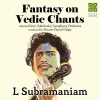
Fantasy On Vedic Chants
It is not easy to categorize this work as either Indian or Western classical music. It is truly an East-West composition since Dr. Subramaniam has drawn on the most compatible elements of both classical traditions and blended them together seamlessly. The key melodic motive of this composition is the ancient three-tonal Vedic chant. The opening statement of the theme, which is based on only three notes, is played by the solo violin and the cellos sustaining the pedal-tone. This music is not in any time signature. When the theme is repeated for the second time, it is in 5/8 time. As the piece develops there are several Indian rhythmic cycles and rhythmic cadences that are repeated three times, a concept typical of Indian music. There are also sections with complex poly-rhythms created by the soloist and the orchestra with the Indian percussionists. There are various contrasting melodic and rhythmic sections developed from the simple three-toned key motive. The form of the composition itself is new. It is not a concerto form, though it does have three movements, fast, slow and fast respectively. The composer has also incorporated some elements of the Kriti form, a traditional South Indian music form that originated in the fifteenth century. In the Kriti form, which also has three sections (called Pallavi, Anupallavi and the Charanam), the opening sentence is played at the end of each section. In this composition, the key motive is repeated in all the three movements, though not always at the end. Thus it is a totally new concept. There are passages that are completely modal, alternating with passages rich in complex Western harmony. There are also some modal passages with a harmonic structure, the harmony derived from the mode itself. In one section the composer uses several beautiful ragas (modes) in quick succession, creating color patterns and giving an image of chromatic harmony but staying within the framework of both traditions.


